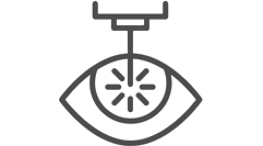Refractive surgery
We offer you the latest technologies for the surgical correction of vision defects, such as myopia, hyperopia and astigmatism. Below are the methods of refractive surgery performed in our practice.
If you’re tired of wearing eyeglasses or contact lenses, you may wonder whether LASIK surgery is right for you. LASIK is a type of refractive eye surgery.
In general, most people who have laser-assisted in-situ keratomileusis (LASIK) eye surgery achieve 20/25 vision or better, which works well for most activities. But most people still eventually need glasses for driving at night or reading as they get older.
LASIK surgery has a good track record. Complications that result in a loss of vision are rare, and most people are satisfied with the results. Certain side effects, particularly dry eyes and temporary visual disturbances, are fairly common. But these usually clear up after a few weeks or months, and very few people consider them to be a long-term problem.
Your results depend on your refractive error and other factors. People with mild nearsightedness tend to have the most success with refractive surgery. People with a high degree of nearsightedness or farsightedness along with astigmatism have less predictable results.





